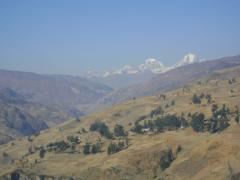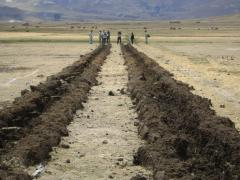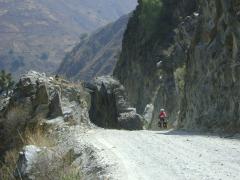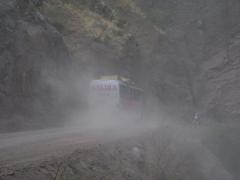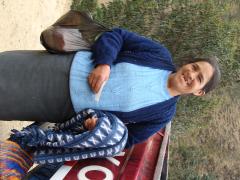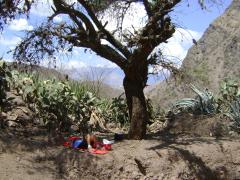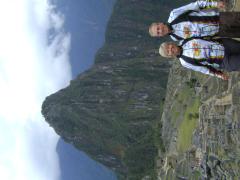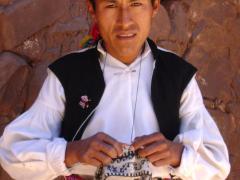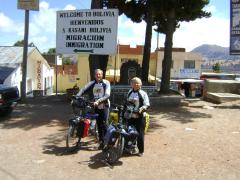Peru
Riding down to Huánuco, A rough day
Note: We've posted our favorite pictures from northern Peru here or as a slideshow.
Yesterday we rode about 45 miles up to 4000 meters (13,120 feet) and then down to 1900 meters (6232 feet) on a nasty, loose, difficult dirt road. Randy crashed on the downhill. He scraped up his arm and hip and bruised a rib. I was behind him and when I came up to him he was down on the ground holding his hip, right on an edge of the road 5 feet from a big, big drop. He was bruised up yesterday but feeling better today. Seeing him lying there scared me. By his position, I thought he broke a hip or a leg. All the rest of the day I was upset.
And Randy got his favorite bike tool (a Topeak Alien multi-tool) taken or lost, probably in the midst of a crowd at a fiesta in a little tiny pueblo at the top of the pass. Everybody was pressing around us. We don't know for sure that somebody took it then, but it was gone right then. He had used it earlier that morning. We have to find a replacement for some of those tools now.
And Randy lost his sunglasses somewhere, so was riding all day with no protection against the immense dust of the road.
The dogs, who are always very protective of their territory, seem much more aggressive then usual. read more here... lee mas aquí... »
Celebrations and Ruins in Huánuco Pampa
Visiting wonderful archaeological sites along the way has been one of the many joys of traveling through the Americas. Occasionally it requires a good hard hike to get there. We had no intention of visiting the Peruvian ruins of Huánuco Pampa (also known as Huánuco Viejo) but while we were riding through La Unión, the local pride in this beloved site got our curiosity going. We could have taken a 5am bus up to the 3700 meter plateau but we didn't want to get up that early, we needed some exercise on our day off from riding, and it's far more direct to walk, so we headed up the narrow canyon to visit old Inca Ruin, Huánuco Pampa.
I was very impressed on how treacherous this route was but it was a major walking thoroughfare for the local people. Slippery rubble lined the route the first first few hundred meters. It seemed not to bother the locals as they knew this was the shortest route from the high pampa flat plateau down to the town of La Unión 700 meters below. It was a beautiful sunny morning and just the right temperature for this adventure. We greeting everyone as we passed by. "buenos dias!" to the shepherds and the cowboys leading the horses and donkeys laden with recent harvested goods. "Hola" to the school children riding donkeys or hiking down with plastic backpacks on their tiny backs. "Como esta" to the woman riding the horse 6 hours from her farm high in the mountains. The most amazing was the very ancient woman who trekked this arduous route with her cane. read more here... lee mas aquí... »
Riding the dusty Rio Mantaro from Huancayo to Ayacucho
We have been riding in the low desert river valley lands at about 7000 feet elevations. The last 4 days have been been very, very hot, dusty, remote, and buggy. We are very dirty. We are taking time out of today's ride to clean the grit out of our teeth, escape form the high temps. and enjoy the pleasures of civilizations for half of a day in Huanta. A bed, a shower, Internet and food other then pollo frito (fried chicken) and arroz (rice).
It is an amazing land. We dropped down 3000 feet and everything changed from cold to hell. It reminds me of some of the landscape near Tucson, Arizona where various cacti adorn the barren landscape. I am amazed how people can eek a living out of land so barren, devoid of resources and forgotten by everyone including the government. This land once was terrorized by a group of rebels called the Shining Path (Sendero Luminoso) but they have long ago abandoned this place and left it to the vultures. Very few buses, cars or trucks passed by us in this rugged, dusty, forsaken place. The land is too dry to support sheep but we did encounter shepherds herding goats along with pigs, a few cows, and donkeys. It is so strange to see women in skirts, blouses, fancy hats, a babies slung on their backs tending to their herds and knitting some kind of clothing or such. The women all through Peru knit. They stand or sit and just knit. read more here... lee mas aquí... »
Working with Kiva and Microfinanzas Prisma in Huancayo
One of the objectives of our trip was to spend some time volunteering for various organizations, and getting to know the area and meeting the people that way. We volunteered with Friendship Bridge and Kiva.org in Guatemala last year, and Kiva was kind enough to set up a task in Huancayo and Tarma, Peru. Our job was to visit loan recipients, interview them so that we could write update their profiles on Kiva, and verify that the loan data were all correct.
Two marvellous young women hauled us all over the back country of Peru searching out the selected Kiva borrowers. In Huancayo we took more buses in one day than we could have imagined, visiting what seemed like dozens of little villages outside the city. In Tarma they arranged a 4-wheel-drive and a driver to haul us all over creation to find the clients. In one case we spent about an hour and a half climbing one incredible road up to a remote village... and then found that the woman was not home! However, we eventually found her husband and he was delightful. read more here... lee mas aquí... »
FAQ: Don't you get tired?
This is an attempt to answer a Frequently-Asked-Question, both at home and on the road: Don't you get tired?
I think there are two different questions being asked. The first is, "Don't you get physically tired riding all that way?". The short answer to that one is: Yes, we get physically tired, and we rest and that solves it.
But the other question people are asking us is, "Don't you get tired of it? or bored?". And that one has a more complicated answer.
Yes, we sometimes do get tired of it. Sometimes the road is the same for a few days. Or the scenery and challenges seem to remain the same. Or the challenge seems a bit too much for a while.
Our standard prescription for a bike tourist that gets discouraged is easy: Rest for some time, and it won't seem so overwhelming. We know of one cyclist who, after riding all the way across Europe in record time, suddenly started feeling like all the people in the country where he was riding were looking at him wrong, like they were out to get him. We think he was tired, and should have slowed the pace, or stopped to rest a few days. But he was on a flight home within a couple of days, having aborted his trip. Cyclists often don't know how tired they really are.
Another thing that's important is to avoid dwelling on the ultimate destination. Our ultimate destination is Ushuaia, in Tierra del Fuego, at the bottom of South America. That's still a long way away. read more here... lee mas aquí... »
In Cusco!
We have just arrived in Cusco, Peru. We will play tourist for a couple of days before going to the famous Inca ruins, Machu Picchu. We took the bus from Ayacucho to Cusco. During the 20 hour bus ride, the views where tremendous from the low river valleys up to the high mountain passes of 4300 meters. The road was mostly dirt, dusty and rugged. The central part of the Peru highlands are desert and dry, bone dry. The rainy season will start sometime near the end of September but for now it has been months without a good rain. I was very glad to be riding in a bus and not having to ride the terrible roads over five extremely high mountain passes and down to the hot dry river valleys. There was no in betweens, either it was up or it was down.
There was one bad thing that did happen. My camera got stolen in the market in Ayacucho right before we where going to catch the bus. I am so bummed and mad. We had our bikes fully loaded and we stopped to buy some bread. I was right next to my bike and Randy next to my bike. I was buying bread and some one distracted Randy with a stupid question which he turned to answer. When I returned to my bike, the camera was gone. There were so many people around and not one person saw what happened. The worst part of getting my camera stolen is the timing. It was one week before we go to the famous ruins of Machu Picchu. I will miss that 10x zoom.
The good news, all the photos backed up except for one day which is nothing in the scheme of things. read more here... lee mas aquí... »
Machu Picchu
Every tourist in Peru must go to Machu Picchu, the legendary lost city of the Incas. So we went! We took a tour of the Inca's "Sacred Valley" and then took the train to Aguas Calientes, the jumping off point.
In the morning we got up at 3:45am to start the hike up to the site, because we wanted to see the sun rise on the mountains. It was a good solid hike up the path (more sane people take the [expensive] bus up there). And it was delightful to see the light come up on the really steep green mountains all around us.
Up on top we took a tour (not the best) and then Randy hiked the steep staircase-like trail up to the top of the pointy mountain that's in the back of every Machu Picchu picture, Huayna Picchu. Nancy got out her watercolors and spent hours drawing the site.
The best part of the whole thing was just sitting and looking at the panoramic view of the site with Huayna Picchu in the background. You could just look at it forever. read more here... lee mas aquí... »
Pavement! Cusco to Lake Titicaca
We finally got started riding again and headed south from Cuzco on delightful paved road. It was paved all the way! Sometimes it was smooth, sometimes rough. Sometimes there was a good shoulder, sometimes not, but it was delightful. The traffic was moderate, the weather was good, the one climb (over a 4300 meter or 14,100 foot) pass was gentle. We took 5 days for the ride, and while we were tired when we got to Puno and Lake Titicaca, we were sure happy with the road.
We got to visit one ruin, Raqchi, that we'd never even heard of. But the guide was good and it was an interesting place, constructed in 1300 A.D. or so by the Incas apparently primarily as a food storage location, as there are more than 150 storerooms that were used for grain. But there were lots of artisans there too, as there still are today. read more here... lee mas aquí... »
The Islands of Lake Titicaca
Lake Titicaca is a massive lake, the highest navigable lake in the world at an elevation of 3,812 meters (12,507 feet). Both Peru and Bolivia share this deep blueish-green lake with several islands on the Peru side and several on the Bolivia side which are inhabited by indigenous people who mostly speak Quechua and Aymara, two languages that date from the Inca empire. A visit to the islands is an important part of visiting this natural wonder of the world.
We took a two day boat trip to three islands on the Peruvian side of Lake Titicaca: Uros, Amantaní and Taquile. We first visited the Uros Islands, which in reality are dozens of floating artificial islands. Each island is made of reeds which are bound together and maintained by the inhabitants. People actually live on these small floating islands in reed houses. Not only are the houses and the islands themselves made of reeds but they make boats out of them too. Is is fascinating to see all the different designs of boats made solely of reeds. The people of the islands used to make a living from fishing, but this has replaced by tourism on most of the islands. The women wear incredibly bright neon-colored clothes which glow against the yellow reeds and blue lake and pastel-colored sky. read more here... lee mas aquí... »
Entering Bolivia!
We entered Bolivia today. We asked cyclists already in the country whether they were sensing any unrest or finding any problems, and none of them were. So we decided to head on in. And even the news shows that all the issues have been in the eastern part of the country, which was far from our route anyway.
The one hurdle we had to cross that we haven't anywhere else on our trip: We had to get a visa! There was a gob of paperwork and $135/person to be paid for the privilege. Bolivia started this program (exclusively for US citizens) several months ago in the interest of "reciprocity". It only makes sense. If Bolivian citizens want to go the US, they have to jump through all these hoops (and far more, really). And we knew about this hurdle for many months.
We had thought we could get the visa cheaper ($100) Bolivian consulate at the last city in Peru, Puno, but when we showed up at their doorstep they told us they were out of visas and didn't know when they'd come.
For other cyclists, our friend Andrew wrote a great article about how US cyclists get a Bolivian visa.


